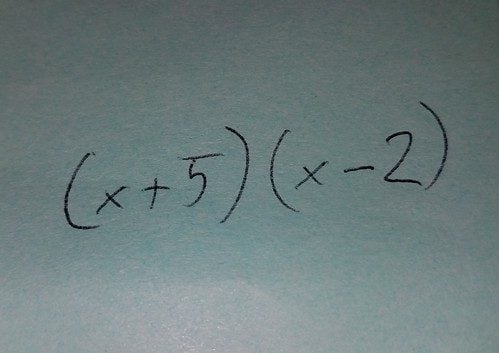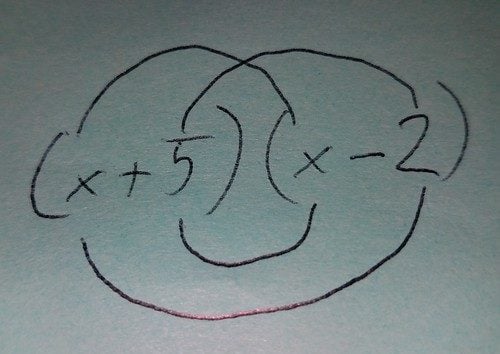You are using an out of date browser. It may not display this or other websites correctly.
You should upgrade or use an alternative browser.
You should upgrade or use an alternative browser.
I need help with a math question
- Thread starter RA1D3R
- 25 comments
- 34,034 views
- 8,444

- Auckland
- Lazer0pz
Basic Quadratics...
So the equation is Y = 3[(x+5)(x-2)].
First, multiply (x+5)(x-2) to get x²+3x-10
Y = 3[(x+5)(x-2)]
∴ Y = 3[x²+3x-10]
Multiply everything in the bracket by what's outside the bracket..
∴ Y = 3x²+9x-30
Waiting for someone to realise that they've been tree'd
So the equation is Y = 3[(x+5)(x-2)].
First, multiply (x+5)(x-2) to get x²+3x-10
Y = 3[(x+5)(x-2)]
∴ Y = 3[x²+3x-10]
Multiply everything in the bracket by what's outside the bracket..
∴ Y = 3x²+9x-30
Waiting for someone to realise that they've been tree'd

- 7,666
- Exorcet
- OE Exorcet
Order of operations is PEMDAS
Parenthesis
Exponents
Multiply
Divide
Add
Subtract
P
y = 3 ( x + 5 ) ( x - 2 )
since x is an unknown, we can't do anymore in the ()'s
E
No exponents
M
y = 3 ( x + 5 ) ( x - 2 ) = (3x + 15)(x - 2) = 3x^2 + 15x - 6x - 30
D
None
A/S
3x^2 + 15x - 6x - 30 = 3x^2 + 9x - 30
If I pretend not to see the post above me am I tree'd?
Parenthesis
Exponents
Multiply
Divide
Add
Subtract
P
y = 3 ( x + 5 ) ( x - 2 )
since x is an unknown, we can't do anymore in the ()'s
E
No exponents
M
y = 3 ( x + 5 ) ( x - 2 ) = (3x + 15)(x - 2) = 3x^2 + 15x - 6x - 30
D
None
A/S
3x^2 + 15x - 6x - 30 = 3x^2 + 9x - 30
If I pretend not to see the post above me am I tree'd?
- 29,794

- Glasgow
- GTP_Mars
I am given this question,
Consider the following formula: y = 3 ( x + 5 ) ( x - 2 )
Which of the following formulas is equivalent to this one?
A. y=3x2+9x-30
B. y=x2+3x-lO
C. y=3x2+3x-lO
D. y=3x2+3x-30
I know the answer is A, but can someone explain why?
The rules of multiplying out quadratics is FOIL (first - outer - inner - last).. and multiply out the brackets first...
With (x + 5) (x - 2):
Your 'firsts' are x * x = x²
Your 'outers' are x * -2 = -2x
Your 'inners' are 5 * x = (+)5x
Your 'lasts' are 5 * -2 = -10
So, (x + 5) (x - 2) becomes: [x² - 2x + 5x - 10] which equals x² + 3x - 10
Multiply the whole lot by 3, and you get:
y = 3x² + 9x - 30
--
@ Exorcet - not as tree'd as me

- 1

- United States
why do you multiply the whole thing by 3?The rules of multiplying out quadratics is FOIL (first - outer - inner - last).. and multiply out the brackets first...
With (x + 5) (x - 2):
Your 'firsts' are x * x = x²
Your 'outers' are x * -2 = -2x
Your 'inners' are 5 * x = (+)5x
Your 'lasts' are 5 * -2 = -10
So, (x + 5) (x - 2) becomes: [x² - 2x + 5x - 10] which equals x² + 3x - 10
Multiply the whole lot by 3, and you get:
y = 3x² + 9x - 30
--
@ Exorcet - not as tree'd as me
- 89,149

- Rule 12
- GTP_Famine
The original equation is y = 3 (x+5)(x-2)why do you multiply the whole thing by 3?
@Touring Mars solved (x+5)(x-2). Multiplying it all by 3 then solves 3(x+5)(x-2).
- 2,227

- Bács-Kiskun
The Holy Mother of necroposts is among us!
- 35,753

- Downtown North Dakota
- Cy-Fi
And they signed up today to ask that...The Holy Mother of necroposts is among us!
- 3,070

- Norway
Don't say it like it's a bad thing. They signed up to ask!And they signed up today to ask that...
- 3,070

- Norway
2019 - 2011 = 7Wow.. After 7 years lol.
@kikie Perhaps you should buy two copies and give one to GTV0819

GTV0819
(Banned)
- 6,084

- Papua New Guinea
Oh please.

Sorry, huh? I forgot to put there that it was more than 7 years ago since I've been carried away for looking at the actual date of the original post but at least I do know that it isn't exactly 8 years yet.
Come on, just because I simply said '7' and not '8', you already became so merely amused about it.

- 3,070

- Norway
Sorry, huh?
It was nothing more than a friendly joke.Come on
See, it worked

GTV0819
(Banned)
- 6,084

- Papua New Guinea
Okay. Just explaining in case you didn't happen to know.It was nothing more than a friendly joke.
See, it worked

Wow.. After 7 years lol.

I didn't even notice that this thread was revived after almost 8 years. If I knew then what I know now, I'd have been a math wizard by now.
Last edited:
GTV0819
(Banned)
- 6,084

- Papua New Guinea
Well, yeah. It seems I'm the first one here to notice the original date of this thread after it was left unbothered for a very long time hahaha.
I didn't even notice that this thread was revived after almost 8 years. I knew then what I know now, I'd have been a math wizard by now.

Danoff
Premium
- 34,306

- Mile High City
why do you multiply the whole thing by 3?
Since you've been curious about this for so many years, I figured it's worth explaining a little further. Alternatively you could have multiplied just the first one set of brackets by 3. For example:
(3x+15) (x -2)
or another alternative
(x+5) (3x-6)
Edit:
For completeness:
also (x -2)(3x+15)
also (3x-6)(x+5)
Doesn't matter what order you perform the multiplication in.
- 5,105

- Panama City, FL
My algebra teacher tought us to multiply two binomials with a "monkey-face."  OK, this was a L-O-N-G time ago...
OK, this was a L-O-N-G time ago...
Write the expression down:

Then draw lines above from the first and second term in the first set to the first and second term in the second set. then draw lines below between the inner terms and the outer terms.

Do the multiplication for each line you drew and add them all together.
As to why you multiply the whole thing by 3, well, it's because "x-squared plus 3x minus 10" is ONE number, not 3. You can't multiply by part of a term.
 OK, this was a L-O-N-G time ago...
OK, this was a L-O-N-G time ago...Write the expression down:

Then draw lines above from the first and second term in the first set to the first and second term in the second set. then draw lines below between the inner terms and the outer terms.

Do the multiplication for each line you drew and add them all together.
As to why you multiply the whole thing by 3, well, it's because "x-squared plus 3x minus 10" is ONE number, not 3. You can't multiply by part of a term.
Danoff
Premium
- 34,306

- Mile High City
My algebra teacher tought us to multiply two binomials with a "monkey-face."OK, this was a L-O-N-G time ago...
Write the expression down:

Then draw lines above from the first and second term in the first set to the first and second term in the second set. then draw lines below between the inner terms and the outer terms.

Do the multiplication for each line you drew and add them all together.
As to why you multiply the whole thing by 3, well, it's because "x-squared plus 3x minus 10" is ONE number, not 3. You can't multiply by part of a term.
I feel like this method and the foil method are actually somewhat counter-productive and difficult to remember. Doesn't it make more sense to just distribute the multiplication?
(x+5)(x-2)
becomes
x(x-2)+5(x-2)
x^2-2x+5x-10 => x^2+3x-10
So 3(x+5)(x-2) can be distributed as (3x+15)(x-2) which can be distributed as 3x(x-2)+15(x-2) which is (3x^2+9x-30).
I don't know if it's true for anyone else, but this makes a lot more sense to me than trying to remember to do foil or anything else, and it even scales better to harder problems.
Danoff
Premium
- 34,306

- Mile High City
Don't really see the difference, as doing the multiplication for each line you drew is distributing the multiplication. I agree that it doesn't scale up to bigger polynomials, though.
Yea I mean it's the same thing. I just wish I had been taught it more directly than trying to remember monkey face or FOIL or whatever.
- 4,722

- United Kingdom
Is the answer maths?I need help with a math question


